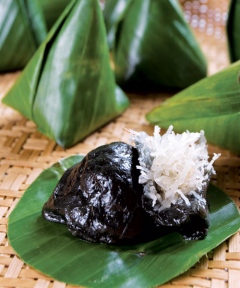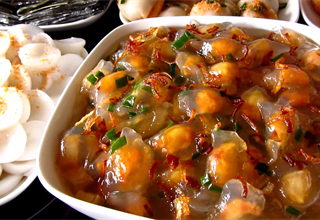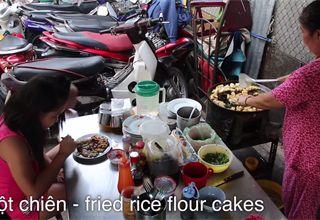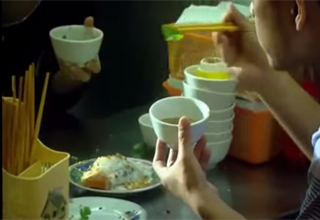The central province of Binh Dinh, around 1,655 kilometers south of Hanoi, is often described by many as a cradle of Vietnamese traditional martial arts.
 Banh it la gai, a small black cake, is becoming popular as a desert and snack at festivals and parties
Banh it la gai, a small black cake, is becoming popular as a desert and snack at festivals and parties
But for food lovers, Binh Dinh is the land of “banh it la gai,” a rice-based treat with a distinctive black color and refreshing flavor, Mon Ngon Viet Nam (Vietnamese Delicious) Magazine reported.
The name indicates the two common features of the cakes -- “it” means “little” to refer to the size of a serving for it only takes two to three bites to finish off a cake, and “la gai” is a kind of thorn leaf commonly found in the central region. It is an irreplaceable ingredient that gives the cake its unique color.
Despite their seemingly unappetizing look, the pyramid-shaped cakes draw food lovers with their la gai aroma and the refreshing flavor of the stuffing made from ground coconut or ground green bean.
But making the tiny cakes is a time-consuming process that requires both hard work and patience.
Banh it la gai is made from five ingredients, the others being sticky rice, sugar, and banana leaf.
The la gai leaves are washed, boiled, and ground in a stone mortar until they become a black powder.
But they grow only between August and the Lunar New Year which falls between mid-January and mid-February, and are preserved for use during the rest of the year.
Yen, a cake maker in the province’s Quy Nhon city, said: “To preserve la gai for later use, we mix the leaves with sugar. Five kilograms of the leaves are mixed with 3.5 or four kilograms of sugar.”
The mixture is then cooked over a fire until it achieves a jelly-like consistency and turns black. In this state it can be preserved for months, according to Yen.
The quality of the cake is heavily dependent on this cooking process.
“The mixture must be cooked for exactly the right length of time,” she said. “If it is undercooked, the cake will be watery, and if it is cooked for too long, the cake will turn hard.”
Only quality glutinous rice will give the cakes their chewy texture. The rice is soaked overnight in water before being ground and kept in a bag for a day or two. When it dries, it forms a block of flour which is again ground.
The rice flour and the la gai mixture are mixed together and ground yet again to create the cake’s chewy texture.
“This is the secret of making the cakes,” Yen said. “If you skip this step, the cakes will still look good but some people will be able to distinguish the difference in quality between them and those made from dough that has been ground twice.”
The stuffing can be made from either ground coconut or green bean though the latter is less common due to the hard work involved in making it.
The beans are soaked in water and cooked over a fire.
“You have to stir the beans constantly or else the bottom will burn,” a Binh Dinh local said.
The beans are ground and rolled into small balls for use as filling.
The cakes are then steamed and wrapped in banana leaves to form little pyramid-shaped packages with square bottoms.
The banana leaves are often heated over the fire or dipped in hot water to soften them, making it easier to wrap the cakes.
Banh it la gai whose aromatic, sweet taste is said to complement the bitter flavor of green tea, is often used as deserts or mid-day treats in festivals and parties.
It is a tradition for newly-wedded brides to make banh it la gai to gift to their parents three days after the wedding as a gesture of gratitude to them and ancestors after moving to their new home.
From being a simple treat invented by Binh Dinh locals, banh it la gai has nowadays become a must-try delicacy for visitors to the coastal province and an essential gift to take back home to their families.
Source: MNVN, TT
















COMMENTS